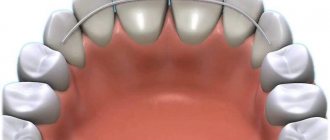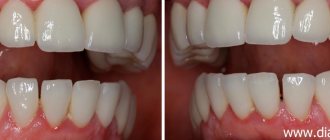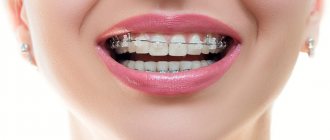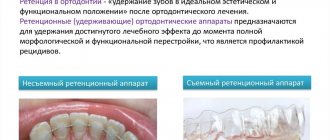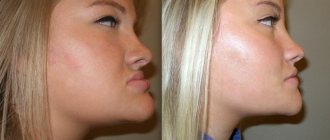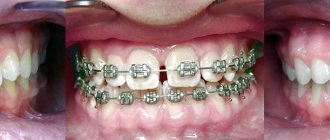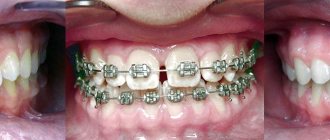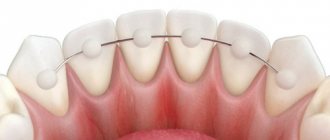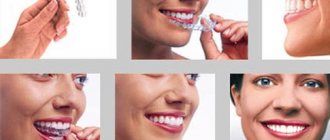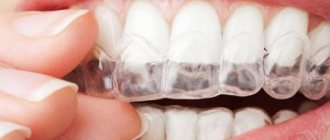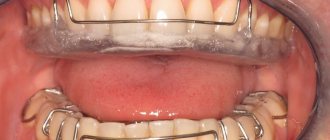Hi all! My name is Sakadynets Alexander, I have been practicing for 12 years and the number of my patients has exceeded 1000. Very often I hear repeated questions from my patients, and I understand how little quality information there is on the Internet and other sources. Sometimes the questions are logical, sometimes they are formed from incorrect information taken from various sources. Alas, myths and prejudices regarding braces still exist in society: supposedly braces contribute to the development of oral diseases, treatment with braces is painful, braces are created only for people under 18 years of age, etc. So, it’s time to collect all these questions in a bunch and try to give explanatory answers to them. I would like to note right away that not a single article can replace a live consultation with a doctor; it is for general informational purposes only.
I want braces on one jaw!
Quite a tempting option for many. But it should be understood that the answer lies already in the name “bracket-SYSTEM”, which implies the SYSTEMIC work of the orthodontic apparatus. And initially, such a decision may be completely wrong, and the amount saved will no longer be so, because all the treatment, and most importantly - time, will go down the drain.
Why?
It's all about the relationship between the upper and lower jaws: when one row of teeth moves, the other follows. And the conclusion from this is the following: braces are not installed with the aim of “straightening” some teeth. The braces system helps to change the position of the dentition in order to improve the bite! Simply put, a proper bite is when one jaw fits over the other like the gears in a watch.
What happens while wearing braces on one jaw? While the system has moved the tooth in the desired direction, another row of teeth tries to move it back. However, in some cases, the option of installing braces on one jaw is acceptable. For example, if the bite is already correct, but there is symmetry of the jaws. Or when connecting another jaw is necessary based on the patient’s clinical case.
Photo while wearing braces
Photo after wearing braces
Fixed products
Fixed retainers are a fairly rigid wire that is secured with a special glue to the back of the teeth. The installation can only be performed by an orthodontist.
Such structures can be installed before removing the bracket system, or immediately after it. Before the procedure, it is important to prepare the oral cavity and clean it from plaque and tartar.
It doesn't take long to get used to such retainers. This will take a maximum of a week. And their main advantage is that they are invisible to others.
Other advantages of the products:
- they cannot be lost;
- act on the teeth continuously;
- do not cause discomfort.
Negative points:
- difficulty of oral hygiene;
- the need for constant visits to the doctor;
- there is a risk of peeling off.
There are cases when different retainers are used in combination. For example, fixed ones are for the upper jaw, and removable ones are for the lower jaw.
Will braces ruin my teeth?
Let me say right away that braces do not damage your teeth. But only subject to hygiene rules and doctor’s recommendations. But here it is better to dispel several myths at once:
No. 1 Teeth under braces will definitely deteriorate
Nothing exactly happens under the braces, but the whole problem usually occurs around the braces - if the patient does not brush his teeth after every meal, then caries forms as a result.
Or if the patient has a strong tendency to form plaque (in this case, hygiene should be more careful). But if the patient could not agree on hygiene during treatment, then I usually suggest, and sometimes insist, that the orthodontic treatment be completed.
No. 2: The enamel may come off along with the braces.
When removing the braces, the doctor leaves some of the glue on the tooth, which is then easily removed with a bur, and then the teeth are polished. In this case, the enamel remains intact and unharmed.
#3: Teeth may fall out after braces.
Basically, patients understand that after proper treatment this is in no way possible. Mobility of teeth during treatment with braces - this happens, and this is normal (after all, teeth move, and this is quite logical). Retention, consisting of both removable and non-removable devices (retainers, mouth guards, plates), will help maintain the position of teeth after treatment, which will help keep the teeth in their correct position.
Prevention
Let's look at the recommendations that need to be followed to avoid loosening of teeth after removing braces.
When using removable aligners:
- the product must be worn constantly for the first six months;
- then the mouthguards are worn at night for another year;
- After another year and a half, you can wear them every other night.
When using permanent retainers:
- it is important to check twice a month how well the structure is secured;
- structures must be used and cleaned correctly.
What is a good orthodontist?
Personally, I am always in favor of the patient receiving at least two third-party opinions. Orthodontic treatment must be approached very seriously, because you are committed to a relationship with the doctor for 1-2 years (or even more). Without mutual understanding, orthodontic treatment is doomed! There are several most important criteria when choosing a doctor:
- High-quality collection of information/diagnostic data
The doctor must make impressions, then carry out calculations on the models, study the OPTG image or CBCT (3-D image), and take intraoral photographs. ONLY after this can you begin treatment with the bracket system. Taking photographs is also a very important diagnostic step.
- Reviews and reputation
I won’t say obvious things here, but it’s worth paying more attention to the doctor’s actual work, rather than reviews on his personal page. By the way, negative reviews are often really unsolicited, but they can be found for literally every doctor (even the best of the best), so filter the information received. Well, no one canceled the recommendations of friends.
- Availability of diplomas/certificates
Having certificates is far from an empty phrase. This suggests that the doctor wants to develop in his field and know about new developments in the field of medicine. Do not hesitate to ask questions about where the doctor received his knowledge, practice, etc.
- Employment
Sometimes we have to work quickly, on the fly. But alas, the case is not always immediately clear. And in general, orthodontics is a science where you need to think a lot. After all, bite alignment is a kind of arcade game for the doctor. Just clarify what the doctor's plans are for you and make sure that the doctor treats your case carefully.
Orthodontists KANO
Signs of pathology
Incorrect distal bite is conventionally divided into 2 types based on its characteristics. These are facial and intraoral changes. Their most severe severity is observed in adults in the complete absence of treatment.
Facial manifestations of distal occlusion:
- Violation of facial proportions - asymmetrical displacement of the lower jaw back and a small, sloping chin.
- A noticeable state of always half-open mouth.
- Change in the natural shape of the upper lip - reduced in volume, upturned or very short.
- Deformation of the lower lip.
- The teeth of the upper jaw are more developed than the lower jaw, the central upper incisors protrude strongly forward.
- Sharply defined chin fold.
Such changes in the shape of the face negatively affect the appearance, the face becomes bird-like.
Intraoral signs of a distal anomaly are as follows:
- There is no closure between the lower and upper jaw.
- The teeth of the upper frontal group are noticeably moved forward.
- The lateral teeth are located abnormally relative to each other.
In most cases, distal occlusion is formed against the background of other pathologies - diastema, trema, open or crossbite.
I'm already old/too old for braces
In fact, today the framework in orthodontic treatment has been completely erased. Of course, each age has its own subtleties of work for a doctor. However, the result is always the same. And one more fact - people sometimes lose their teeth not because of caries and other dental problems, but because of an incorrect bite. When the load is distributed unevenly, it ultimately leads to bone loss and tooth wear.
I will not tire of repeating that we do straight teeth not only to solve aesthetic problems. Often this will save you from early tooth loss.
Causes
In young children, distal occlusion is a physiological norm. The upper jaw protrudes above the lower jaw by a distance of 1 to 10 mm. This is necessary for sucking the mother's breast. Gradually, the distal bite becomes orthognathic.
Reasons for the development of prognathia:
- Vitamin D deficiency. Causes rickets at an early age, the consequence of which is distal or mesial occlusion.
- Premature loss of baby teeth or their removal.
- Genetic factor.
- Calcium and fluoride deficiency in the body of a pregnant woman causes prognathism in the child.
- The influence of external factors - the use of a pacifier, sucking of fingers and other objects in childhood.
- Chronic pathologies of the respiratory system, causing disruption of normal nasal breathing. This leads to improper jaw development.
- Poor posture. A bent back and a head down provoke the development of jaw pathology.
- Injuries that damage the jaw bones.
- Some types of speech defects, due to which distal occlusion develops.
After getting braces, will I have to go on a strict diet?
Undoubtedly, there will be changes in diet, but they are absolutely not worth the fears associated with the myth that braces deprive you of gastronomic joys. You will just need to be more careful and exclude only some of the products (nuts, puffed rice, popcorn, caramel, nougat, seeds, chewing gum, etc.).
First of all, this is necessary in order not to clog the spaces between the grooves of the braces, where bacteria can accumulate and caries can develop. You should also avoid drinks with dyes, hot and cold drinks (temperature changes can cause the braces to come off).
Think for yourself, after all, braces are even a kind of motivation to start a healthy lifestyle, because it is mainly harmful foods that are excluded.
Eating while wearing braces
Classification of pathology
The following types of prognathic occlusion are distinguished:
- First type. Characterized by underdevelopment of the lower jaw. At the same time, the upper one, in its anatomical structure, develops in accordance with age.
- Second type. It is characterized by excessive development of the upper jaw along with the teeth, while the lower one is formed normally.
- Third type. In this case, changes of the first two types are combined.
- Fourth type. Involves the advancement of the front teeth of the upper jaw, which is insignificant.
Orthodontists also use the Angle classification of prognathia:
- 2 class 1 subclass. It is characterized by a narrowing of the dentition on the sides, and the front teeth of the upper jaw are fan-shaped. There is a sagittal fissure.
- 2nd class 2nd subclass. The lateral teeth are turned along their axis and deviate towards the lips, the upper front teeth tilt towards the palate. There is no sagittal fissure.
Is it possible to wear braces during pregnancy?
Modern braces are absolutely harmless to the body and do not cause allergies. Therefore, wearing them in itself does not in any way affect the course of pregnancy and the intrauterine development of the child. But this is subject to careful oral care! ⠀ Of course, hormonal imbalance affects the condition of the bone, but here it is necessary to conduct research from specialists and only after that decide whether treatment or continuation of treatment during pregnancy is possible. It is better to plan the installation of braces 1-2 months before pregnancy, so that all the necessary studies do not negatively affect the fetus (X-rays, CT scans, etc.). ⠀ According to experienced orthodontists, if a woman becomes pregnant, then there is no need to do anything special. It makes sense to wear braces until you finish breastfeeding, even if it is possible and will be for quite a long time. However, this will allow the bone tissue to normalize, and the woman will not miss out on the results of treatment already obtained before pregnancy. If you are pregnant or plan to become pregnant, be sure to talk to your doctor. Only a specialist will be able to correctly assess your condition and prescribe the necessary course of action!
Is it possible to treat teeth during pregnancy?
Where to remove braces and how much does it cost?
Braces are removed at the dental clinic where the treatment is performed, for example, Family Dent. The cost of the procedure varies widely - from 2,700 to 12,500 rubles. for both jaws. The price depends on:
- difficulties in dismantling the system;
- subsequent procedures of professional cleaning, polishing, remineralization;
- clinic class;
- specialist rating, etc.
The cost of dismantling lingual braces is 2 times more expensive due to limited access to structural elements.
Is it possible to do without retention and what is it even?
Retention is perhaps one of the most important parts of the entire treatment. Why? Teeth are harmful guys, and they will try to return to their original position, which is comfortable only for them. This is called a relapse. But neither I nor my patient want this. That’s why I really insist on retention, often even suggesting double retention.
What is retention? This is a removable or non-removable device designed to hold the dentition in the desired position. This could be a splint, a retainer (an arch behind the teeth), a night guard, or a plate.
Retainer after braces
What types of retainers are there?
A retainer is a special wire attached to the back of the teeth. They are usually fixed in place of the fangs. With their help, teeth do not move apart after braces. The patient hardly feels this product in his mouth.
Varieties of such structures:
- Removable products. They can be single-jawed (used at any time of the day) or double-jawed (worn at night).
- Non-removable products. They are fixed to the inside of the teeth with a special adhesive. After getting used to it (about a week), they do not cause discomfort at all.
The orthodontist will recommend and tell the patient which design to choose, how to wear it and how to care for it.
How to relieve toothache from braces?
- Take the pain reliever at the dosage prescribed by your doctor and at the recommended frequency.
- Use local anesthetics - gels and mouthwashes that dull the pain for a couple of hours.
- Baths with warm salt water soothe pain and heal abrasions of the soft tissues of the oral cavity. The solution should be kept in the mouth for about a minute, and the procedure should be repeated several times a day.
- Relieve inflammation by rinsing or bathing with 3% hydrogen peroxide, which has an antiseptic effect. The 1:1 solution is also kept in the mouth for about a minute. You can also buy a ready-made peroxide-based rinse at the pharmacy.
- Use specialized wax as needed. After tearing off a piece, roll it into a pea, dry the problematic metal element with a napkin and press the pea onto it.
Types of braces systems and their installation
Depending on the degree of complexity of correcting existing defects and the planned time for the patient to wear braces, the doctor suggests two main types of their design:
- Removable bracket system
It is recommended to remove it before eating and while brushing your teeth.
- Fixed system
The system is not removed for the entire duration of treatment. While wearing it, the doctor regularly makes certain adjustments.
None of the patients complained that their teeth hurt from braces when they were installed. Although such a procedure can last 1.5-2.0 hours. The painlessness of the operation is explained by the fact that the design of the braces during installation comes into direct contact with the tooth enamel, which has no nerve endings and simply does not feel pain.
The above installation times are averages. The duration of the operation depends on the following:
- doctor's qualifications and practical experience.
- individual characteristics of the patient’s teeth and jaw.
How to relieve pain at home
Pain appears when installing braces and when changing the arch. You can reduce it at home in several ways:
- Taking painkillers (consultation with a doctor is required!)
- Application of lidocaine gel
- Eating cold food
- Applying a cold compress
- Rinsing your mouth with salt water
To prevent attacks of toothache and keep your teeth in good condition, you need to buy:
- Irrigator
- Brushes for braces
- Mono-beam brush
- Orthodontic brush
- Medical wax
Adaptation period
After the braces are fixed in the desired position and the arch is inserted into the slots, the doctor sends the patient home. From this moment the adaptation period begins. Experts conditionally divide it into three stages: two or three days after installation, the first week, completion of addiction.
First days
Within a few hours after installing braces, the patient begins to experience the first painful sensations. They are not very intense, but the unusual feeling can be an unpleasant discovery.
This is due to the following factors:
- Pressure on the periodontium . The periodontal ligament is a structure that connects the tooth and jaw to each other and ensures a certain position of the tooth. From the first hours, the arc of the system puts pressure on the crown, and after it the root slowly begins to shift, provoking changes in the periodontium. The periodontal ligament is innervated by the trigeminal nerve, which transmits a signal of pain to the corresponding centers of the brain. Unpleasant sensations become stronger at the moment of additional load on the jaws: while biting or chewing food. Such reactions during the first days after installation are a normal reaction of the body.
- Rubbing mucous membranes . The oral mucosa is in constant dynamics: movements occur not only during conversation or eating, but also during the normal process of swallowing saliva. Maximum discomfort is felt in the area of contact of the mucous membranes with protruding parts: locks, hooks, chains, etc. The mucous membrane of the lips is penetrated by a huge number of nerve endings, so any unusual sensations here cause an increased reaction. In addition, irritation and even ulcers may appear here and on the inner surface of the cheeks during the first days after installation.
Rubbing the mucous membrane with braces
Unpleasant feelings in the temples, forehead, back of the head, neck and upper back after installation of the system appear in approximately 15% of patients. A noticeable increase in tooth sensitivity is possible, but it is not associated with the installation of braces, but with the fact that during preparation, dental cleaning of the dentition is carried out to prevent caries during the course of bite correction. You can use toothpaste for sensitive teeth to make this effect disappear faster.
A significant increase in temperature, trembling in the limbs and the appearance of sticky sweat is considered a signal that you urgently need to see your orthodontist. Such manifestations occur in 1.5% of cases and require correction of the system by a doctor.
First week
On the second or third day, the pain syndrome is replaced by a persistent feeling of pressure on the teeth, aching in the lower jaw and even slight myalgia of the facial muscles. Due to unpleasant sensations during this period, appetite may disappear, as discomfort will increase when eating. Children may refuse to eat at all for a while, but hunger will eventually force them to stop the voluntary diet after a few days, so parents need to calmly endure this period and not force the child to eat. It is best at this time to prepare him dishes that do not need to be chewed: mashed potatoes and pureed soups.
In the first week, an inflammatory process may begin in the periodontium, which will further intensify the pain. This happens in cases where the pressure on the tooth is strong enough. By the seventh or eighth day, the discomfort should subside. This happens because the collagen fibers of the periodontal ligaments are restored quite quickly; a period of up to eight days is enough for them to be completely renewed.
Second-third weeks
At this stage, the pain from braces gradually disappears. The process has already started, and the dentofacial apparatus has time to adapt to the changes taking place. If all the rules are followed, chafing and ulcers on the mucous membrane will heal, so the ability to eat normally returns. Biting hard food is still not recommended; you can cut it into small pieces with a knife.
In children and adolescents, adaptation to braces and pain goes away faster due to the high potential for the formation and adjustment of anatomical parameters to existing conditions.
Why do my teeth hurt from braces after activating treatment?
Painful sensations return for several days when the system is activated. After a certain time, the teeth are aligned, the bite is corrected, the ligatures are stretched, and the force of the arc decreases. To restore the effectiveness of ligature braces, the doctor periodically corrects them:
- after 3–4 weeks, renews ligatures;
- after 2–3 months, replaces the arch;
- At each appointment, checks the secure fastening of the locks.
Self-ligating systems need to be activated less frequently. The severity of pain depends on the individual pain threshold and the condition of the dental system. Typically, teeth respond to the next increase in traction within 2–3 days.
